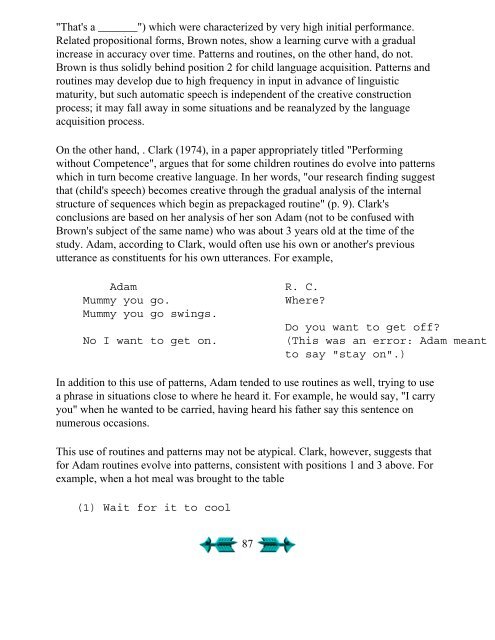Second Language Acquisition and Second ... - Stephen Krashen
Second Language Acquisition and Second ... - Stephen Krashen
Second Language Acquisition and Second ... - Stephen Krashen
You also want an ePaper? Increase the reach of your titles
YUMPU automatically turns print PDFs into web optimized ePapers that Google loves.
"That's a _______") which were characterized by very high initial performance.<br />
Related propositional forms, Brown notes, show a learning curve with a gradual<br />
increase in accuracy over time. Patterns <strong>and</strong> routines, on the other h<strong>and</strong>, do not.<br />
Brown is thus solidly behind position 2 for child language acquisition. Patterns <strong>and</strong><br />
routines may develop due to high frequency in input in advance of linguistic<br />
maturity, but such automatic speech is independent of the creative construction<br />
process; it may fall away in some situations <strong>and</strong> be reanalyzed by the language<br />
acquisition process.<br />
On the other h<strong>and</strong>, . Clark (1974), in a paper appropriately titled "Performing<br />
without Competence", argues that for some children routines do evolve into patterns<br />
which in turn become creative language. In her words, "our research finding suggest<br />
that (child's speech) becomes creative through the gradual analysis of the internal<br />
structure of sequences which begin as prepackaged routine" (p. 9). Clark's<br />
conclusions are based on her analysis of her son Adam (not to be confused with<br />
Brown's subject of the same name) who was about 3 years old at the time of the<br />
study. Adam, according to Clark, would often use his own or another's previous<br />
utterance as constituents for his own utterances. For example,<br />
Adam R. C.<br />
Mummy you go. Where?<br />
Mummy you go swings.<br />
Do you want to get off?<br />
No I want to get on. (This was an error: Adam meant<br />
to say "stay on".)<br />
In addition to this use of patterns, Adam tended to use routines as well, trying to use<br />
a phrase in situations close to where he heard it. For example, he would say, "I carry<br />
you" when he wanted to be carried, having heard his father say this sentence on<br />
numerous occasions.<br />
This use of routines <strong>and</strong> patterns may not be atypical. Clark, however, suggests that<br />
for Adam routines evolve into patterns, consistent with positions 1 <strong>and</strong> 3 above. For<br />
example, when a hot meal was brought to the table<br />
(1) Wait for it to cool<br />
87











